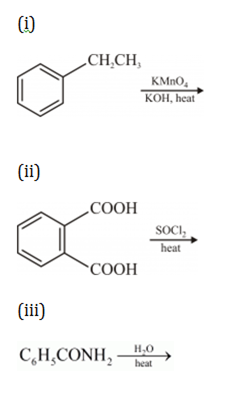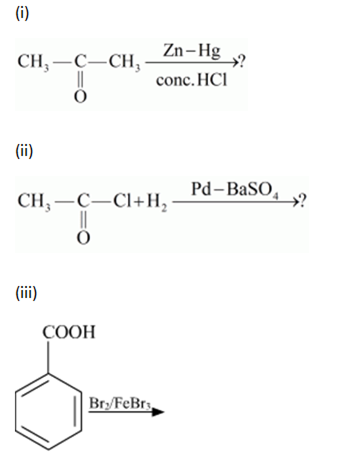 Long Answer Type
Long Answer Type(a) Describe the following giving linked chemical equations:
(i) Cannizzaro reaction
(ii) Decarboxylation
(b) Complete the following chemical equations:

A compound 'A' of molecular formula C2H3OCl undergoes a series of reactions as shown below. Write the structures of A, B, C and D in the following reactions:
![]()
(b) Distinguish between the following:
(i) C6H5-COCH3 and C6H5 - CHO
(ii) Benzoic acid and methyl benzoate
(c) Write the structure of 2- methylbutanal.
(a) Write the structures of the main product when acetone ( CH3-CO-CH3) reacts with the following reagent:
(i) Zn-Hg/conc. HCl
(ii) H2N-NHCONH2/H+
(iii) CH3MgBr and then H3O+
(a) Arrange the following in the increasing order of their boiling point:
C2H5OH, CH3-CHO, CH3-COOH
(b) Give a simple chemical test to distinguish between the following pair of compounds:
CH3CH2CHO and CH3CH2COCH3
 Short Answer Type
Short Answer TypeWrite the equations involved in the following reactions:
(i) Reimer - Tiemann reaction
(ii) Williamson’s ether synthesis
 Long Answer Type
Long Answer Type(a) How will you convert the following?
(i) Propanone to Propan-2-ol
(ii) Ethanal to 2-hydroxy propanoic acid
(iii) Toluene to benzoic acid
(b) Give simple chemical test to distinguish between:
(i) Pentan-2-one and Pentan-3-one
(ii) Ethanal and Propanal
(a) Write the products of the following reactions:

(b) Which acid of each pair shown here would you expect to be stronger?
(i) F — CH2 —COOH or Cl — CH2 — COOH
(ii) 
(a)
(i)![]()
This reaction is Clemmensen reduction.
(ii)
This reaction is Rosenmunds reduction.
(iii)

This reaction is an electrophilic substitution reaction.
(b)
(i) F — CH2 — COOH is a stronger acid than Cl — CH2 — COOH because F is more electronegative than Cl so it will favour the release of H+ ion faster by dragging the electron density towards itself more as compared to Cl.
(ii) Acetic acid is a stronger acid than phenol. On losing a proton, carboxylic acid forms carboxylate ion and phenol forms phenoxide ion. The negative charge is delocalized in both the molecules. The conjugate base of the carboxylic acid has two resonance structures (shown below) in which negative charge is delocalized over two oxygen atoms which stabilizes the carboxylate ion.

On the other hand, in phenoxide ion, the negative charge is delocalized over entire molecule on the less electronegative carbon atom as given below.
Thus resonance in phenoxide is not important as compared to resonance in carboxylate ion.
Further, in carboxylate ion, the negative charge is effectively delocalized over two oxygen atoms whereas it is less effectively delocalized over one oxygen atom and the less electronegative carbon atom in phenoxide ion.
Thus acetic acid is a stronger acid than phenol.
 Short Answer Type
Short Answer Type Long Answer Type
Long Answer Type(a) Write a suitable chemical equation to complete each of the following transformations:
(i) Butan-1-ol to butanoic acid
(ii) 4-methylacetophenone to benzene-1, 4-dicarboxylic acid
(b) An organic compound with molecular formula C9H10O forms 2, 4-DNP derivative, reduces Tollen’s reagent and undergoes Cannizzaro’s reaction. On vigorous oxidation, it gives 1, 2-benzenedicarboxylic acid. Identify the compound.
(a) Give chemical tests to distinguish between
(i) Propanol and propanone
(ii) Benzaldehyde and acetophenone
(b) Arrange the following compounds in an increasing order of their property as indicated:
(i) Acetaldeyde, Acetone, Methyl tert-butyl ketone (reactivity towards HCN)
(ii) Benzoic acid, 3, 4-Dinitrobenzoic acid, 4-Methoxybenzoic acid (acid strength).
(iii) CH3CH2CH (Br) COOH, CH3CH (Br) CH2COOH, (CH3)2CHCOOH (acid strength)
Write the structures of A, B, C, D and E in the following reactions:
Or
(a)Write the chemical equation for the reaction involved in Cannizzaro reaction.
(b)Draw the structure of the semicarbazone of ethanal.
(c)Why pKa of F-CH2-COOH is lower than that of Cl−CH2−COOH?
(d)Write the product in the following reaction:
(e)How can you distinguish between propanal and propanone?
